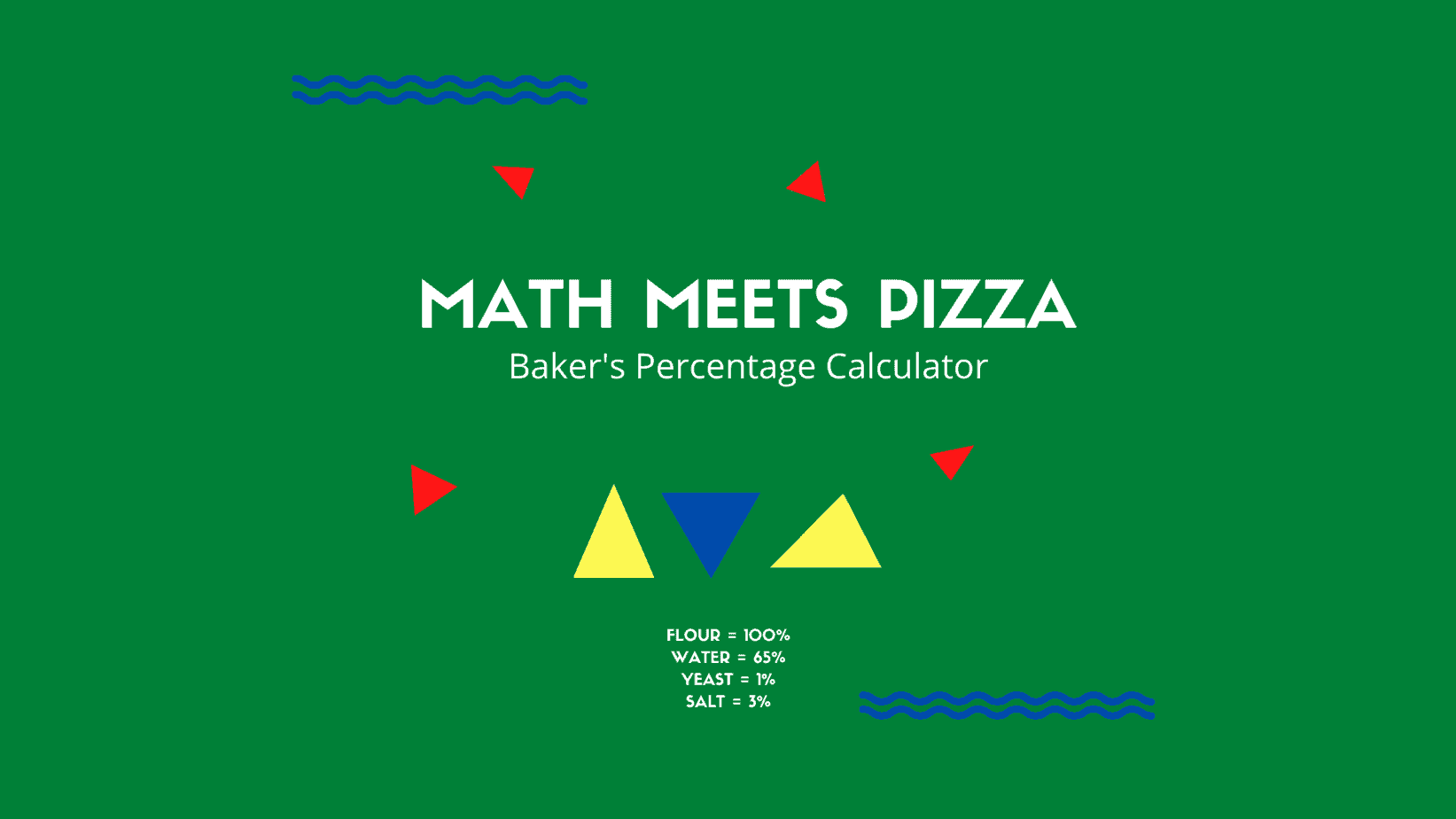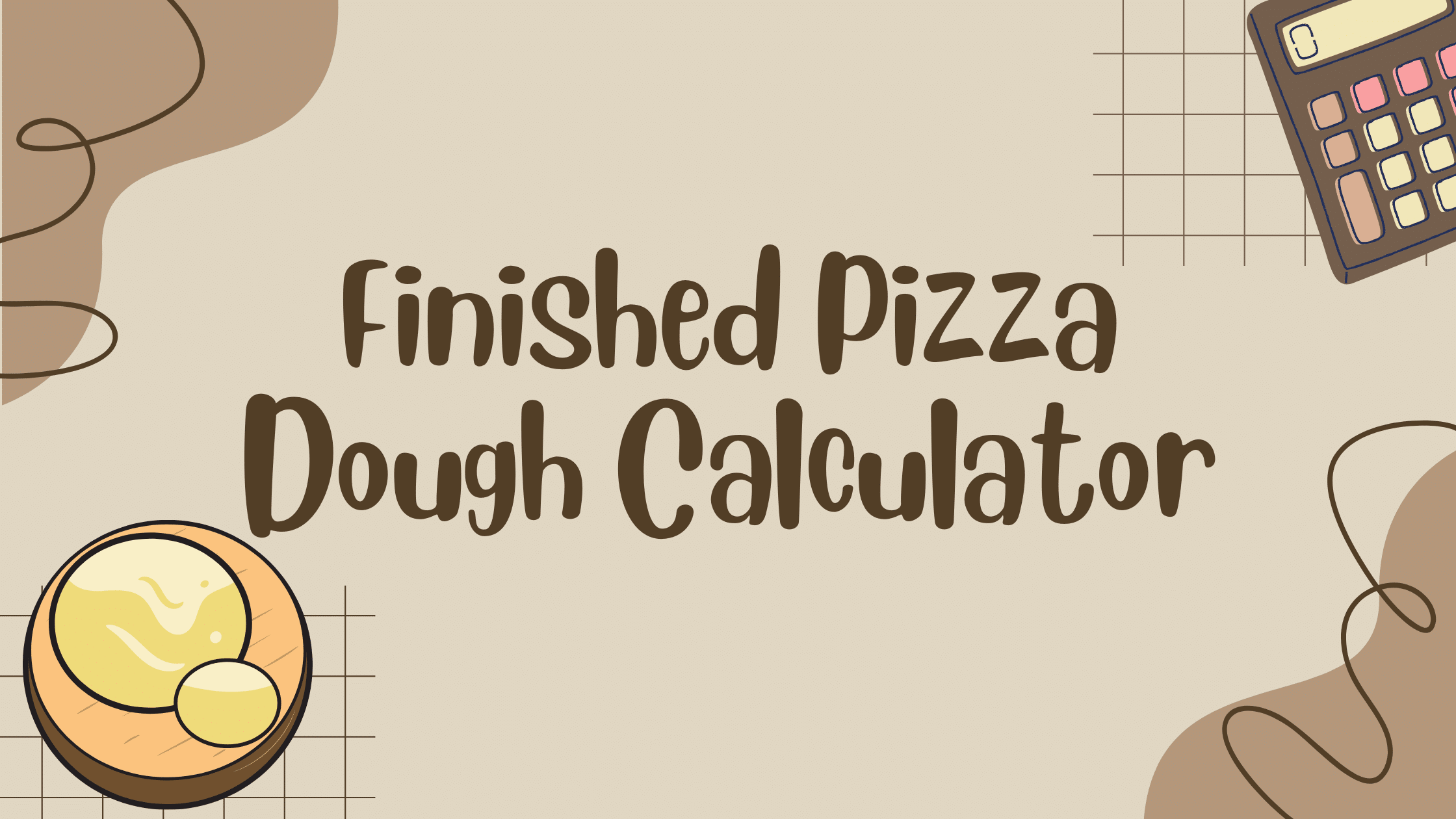The Best Bakers Percentage Chart To Start Making Pizza At Home
This article enlightens beginners and seasoned bakers on applying baker’s percentage charts in pizza dough preparation. By understanding this method, you can tweak recipes to your liking, ensuring consistency in your dough every time you bake.
These baker’s percentage charts for pizza dough will give you a starting point to develop your recipes. Carefully calculate the pizza dough percentages, ensuring the perfect balance of ingredients for the ultimate crust.
First, check the recommended parameters you should use. Remember that these are only recommendations; be creative and make something different.
Let’s get started!
Here’s What You Will Find:

What is Baker’s Percentage?
Baker’s percentage is a vital concept in the world of baking, especially when it comes to crafting the perfect pizza dough. This method isn’t about the actual percentages of ingredients in the final product.
Still, it is a system where the total weight of flour used is always considered 100%, and every other ingredient is measured as a percentage of that flour weight. This approach allows for consistency and scalability in recipes, which is crucial for home bakers and commercial pizzerias.
The simplest recipe formulation technique uses baker’s percentage, sometimes called baker’s math.
Each component in a formula is represented as a percentage of the flour weight in the baker’s percentage, and the flour weight is always expressed as 100%.
Most skilled bakers in the United States may recall a time when the sole scale in most bakeries was a balancing beam scale, and liquids were nearly usually measured in gallon pitchers rather than weighed.
Although balancing beam scales are still extensively used, an increasing number of bakers are using electronic scales for weigh-outs, and gallon pitchers are being replaced with liquids that are weighed alongside the dry ingredients.
For our pizza recipes, we use baker’s percentage for several reasons.
- First, because each is weighed, we can operate precisely with only one unit of measurement.
- Second, scaling a calculation up or down is simple when working with baker’s percent.
- Finally, it allows bakers to communicate in a common language.
This common language allows the baker to communicate with other bakers and rapidly analyze a recipe using the percentages.
What Do You Need to Calculate Baker’s Percentage?
Because pizza baking requires accuracy, a pastry’s texture can be drastically altered by adding too much flour or too little sugar, making it dense and leaden or dry and crumbly. And, unlike measuring cups, the only way to be exact in your baking is to use a scale.
A level cup of flour shrinks to less than a cup with a few taps on the counter.
Consider taking a cup of flour from a bag. You can make a flawless cup of flour by sweeping off the excess with the back of a butter knife.
Consider slamming the cup on the counter a few times. Your cup is no longer full when the flour settles. Flour can compress or puff up depending on how old it is, how you scooped it into the cup, and how humid it is on that particular day.
However, regardless of the weather or the force with which you scoop, 120 grams of flour is always the same quantity of flour.
Here’s What the Pros at Homemade Pizza Pro Use and Recommend
The My Weigh KD8000 is a versatile Bakers Math Kitchen Scale with a large 8000g capacity and multiple weighing modes, including a percentage weighing function for precise baking. Its stainless steel platform is easy to clean, and the backlit weight display ensures easy reading. The hinged gunk shield adds convenience during messy applications—a must-have tool for accurate and consistent measurements in the kitchen.
Components of Pizza Dough
Essential Ingredients
The main ingredients in pizza dough are flour, water, yeast, and salt. Additional elements like sugar or oil are sometimes added for specific dough types.
Functions of Ingredients
- Flour: Provides the structure.
- Water: Hydration affects the dough’s texture.
- Yeast: Responsible for fermentation, affecting the rise and flavor.
- Salt: Enhances flavor and controls yeast activity.
Why use Baker’s percentages for Pizza Dough?
Despite this lengthy post bakers mathematics is not scary math. It’ll be ok. The fundamentals for using bakery percentages is to weigh ingredients accurately, and the individual weight is proportional in an ingredient to flour weight.
Water, salt, and yeast are proportional to total flour weights. We keep flour at the center of everything, making it easy to compare.
Instead, ingredients are proportioned against the rest, but only regarding flour.
To demonstrate this, we show our four main base recipes that can be easily adapted to any other pizza style. If you want to see the recipes, go to our Recipes section.
These pizza percentages refer to the breakdown of the different ingredients used to make a pizza. They indicate the proportion of water, flour, salt, and yeast in a pizza dough. The specific percentages can vary depending on personal preference and regional variations in pizza styles.
Each pizza style has the recommended baker’s percentage for our base recipes; you can adapt them any way you want to reach what is best.
For example, our recipes are based on 65% hydration, the average hydration for yeast doughs. But let’s say you want your crust to be a little more crispy and less bready.
You need only adjust your recipe to decrease the hydration percentage, which adds less water. The same goes for all other ingredients.
Calculating Baker’s Percentages
While percentage represents a fraction of the total percentage, the baker’s percentage represents the product in direct proportion to the amount of flour in the recipe – the total flour in the recipe is 100%.
Consequently, each ingredient will give percentages according to the percentage of all flours. For example, the flour in your recipe should reach 100%.
If the flour were grouped into 10 grams of bread flour and 10 grams of flour, each would make up half of the total flour.
So, if you meticulously calculate the pizza dough percentages, you will ensure that the crust turns out perfectly crispy and fluffy.
Recommended Baker’s Percentage Charts to Make Pizza Dough
The Baker’s Percentage Guides Used by the PROs
At Homemade Pizza Pro, we have taken a modern approach to pizza making but with a sense of tradition.
We studied and reinvented the recipes created by pizzaiolos in Italy, who dedicated their lives to perfecting pizza and adapted them to a homemade version.
After studying a significant number of their recipes and following the Associazione Verace Pizza Napoletana guidelines, we created these bakers’ percentage charts, which can serve as guides to help you create your pizza recipes.
Baker’s Percentage Chart – VPN Guides
| Ingredient | Percentages |
|---|---|
| Flour | 100% |
| Water | 50% to 75% |
| Yeast | 1% to 5% |
| Salt | 1% to 3% |
Note that these recommended baker’s percentage charts do not include ingredients such as oil, sugar, malt, etc.
The reason is that these ingredients are not part of a true Neapolitan Pizza; these are ingredients that pizza makers have added over the years to adapt their versions of pizza.
This is why we have today, among many others, New York Style, Grandma Style, and Chicago Style.
We challenge you to do the same, create your pizza style, and play with your dough ratio chart percentages but always try to stay within the recommended parameters for the best results.
Have fun and make the best pizza!
Baker’s Percentage Chart per Pizza Style
| Ingredient | Neapolitan | NY-Style | Sicilian | Chicago Deep |
|---|---|---|---|---|
| Flour | 100% | 100% | 100% | 100% |
| Water | 65% | 65% | 75% | 60% |
| Yeast | 1% | 1% | 1% | 1% |
| Salt | 2% | 2% | 2% | 2% |
| Oil | – | 5% | 2% | – |
| Sugar | – | 4% | – | – |
| Lard | – | – | – | 4% |
| Malt | – | – | 3% | 2% |
| Butter | – | – | – | 4% |
| Cornmeal | – | – | – | 5% |
Application in Pizza Dough Making
Adjusting Recipes
You can scale the recipe up or down using the baker’s percentage while maintaining the dough’s integrity. This is particularly useful for adjusting the size of your batch according to needs.
Consistency and Quality
By adhering to the baker’s percentage, you achieve consistent quality in your pizza dough. This is crucial for professional bakers and even home bakers who value consistency in their creations.
Advanced Tips and Tricks
Hydration Levels
The amount of water relative to flour greatly influences the dough’s texture. A lower hydration level (around 55-60%) is ideal for a crispier crust, while a higher hydration level (up to 70%) creates a softer, more pliable dough.
Handling Different Flours
Different flours absorb water differently. Bread flour, for instance, can handle higher hydration than all-purpose flour. The baker’s percentage allows for these adjustments.
Additional Baker’s Math Resources

Bakers Percentage Calculator for Pizza Dough: Is as Easy as 123
This Baker’s Percentage Calculator will allow you to you calculate the baker’s percentage for any given pizza recipe in a few seconds.

Baker’s Percentage for Pizza: Mastering the Science of Pizza Dough
In this article, we are going to uncover the math behind making great pizza at home. At first, it will appear a little intimidating, but don’t worry. Let us do the numbers; the only thing you need is your imagination!

Master the Pizza Making Process Controlling these Powerful Pizza Elements
Master the pizza craft with this guide, discover the elements of pizza and become a master pizza baker once you dominate these elements.
Additional Calculators
If you need help determining the ingredients you need for your recipe, check out our Pizza Dough Calculator to get the results in a matter of seconds, and you can download, save, and print your recipe.
If you already have a recipe you like and want to know the baker’s percentage, check out our Baker’s Percentage Calculator. These guides will help you do the math behind the pizza-making process.

Bakers Percentage Calculator for Pizza Dough: Is as Easy as 123
This Baker’s Percentage Calculator will allow you to you calculate the baker’s percentage for any given pizza recipe in a few seconds.

Pizza Checklist: Stuck on Not Knowing How to Start Your Pizza? Here’s Step 1
Pizza Checklist A homemade pizza checklist will help determine whether you can make pizza at home. This comprehensive checklist or …

Pizza Dough Hydration Calculator
Making the perfect pizza dough can be difficult, especially for novice bakers. But with the right tools, anyone can master …

Finished Pizza Dough Calculator: A Quick Shortcut to Pizza Doughball Weight
This Finished Dough Calculator will allow you to you calculate the exact amount of ingredients in grams you need for your pizza dough in a few seconds.
The Last Slice
We made these baker’s percentage charts for you! We want you to be the best homemade pizza baker and share the love of pizza with your friends and family.
In addition to these baker’s percentage charts, we have plenty of resources for you to become the best pizza baker, visit our Learn section for more.
Check Amazon’s Pizza-Making Must-Haves
Why have two pizza peels when you can only have one. This pizza peel surpasses the benefits of wood peels with the convenience of a metal peel. It's made entirely from anodized aluminum for a lightweight design that's incredibly durable, too. It's designed to be used frequently in high-heat pizza ovens.
The Etekcity Lasergrip 800 Digital Infrared Thermometer is a versatile and reliable tool for accurate temperature measurements. Its non-contact design allows you to measure temperatures from a distance, making it safe and hygienic for various applications. With a wide temperature range of -58°F to 1382°F (-50°C to 750°C), this infrared thermometer is perfect for both everyday cooking needs and professional uses.
The built-in laser pointer helps you target the specific area you want to measure, ensuring precision and consistency. Whether you're grilling, cooking, or performing household maintenance, the Etekcity Lasergrip 800 provides fast and accurate temperature readings with ease.
 NerdChef Steel Stone
NerdChef Steel Stone
Making great crusts traditionally requires a 700-1000F wood-fired oven. Nerdchef Steel Stone replicates that performance in a home oven with its super-high heat transfer ability - transferring heat energy 20 times faster than ceramic. It creates beautiful and crispier crusts, gorgeous blistering throughout, and it cooks faster.
The Chef's flour is a general-purpose, high gluten flour that works well for many recipes. "Tipo 00" refers to how refined the flour is. Chef's Flour is best for those who want to bake in their traditional home oven up to 500 degrees Fahrenheit!
Enjoy!
Not a PRO? Not a Problem!
Take a pizza class to bring your pizza skills to the next level,
so you can be a PRO!
Related Posts

Costco Pizza Delivery: Find How You Can Get It Now!
the PROs
People go to Costco’s food court for many different reasons, but the cheesy slice of pizza they serve is among …

Pizza for Beginners: Don’t Buy Pizza, Make It! Here’s How to Get Started!
the PROs
You have this idea that you want to make pizza at home as opposed to ordering it, but where do you start? Don’t worry! Here you will find answers and directions to all your questions.

Pizza Toppings Under Cheese or Over Cheese? [Why the Order Matters]
the PROs
Is Pizza Cheese on Top or Bottom? Hey pizza lovers, are you wondering if you should layer pizza toppings under …
Newsletter
Subscribe to our Recipe of the Week newsletter and receive our partners’ latest recipes, tips, and discount offers.
Keep in Touch!





